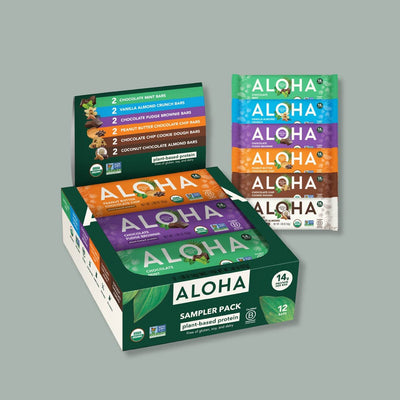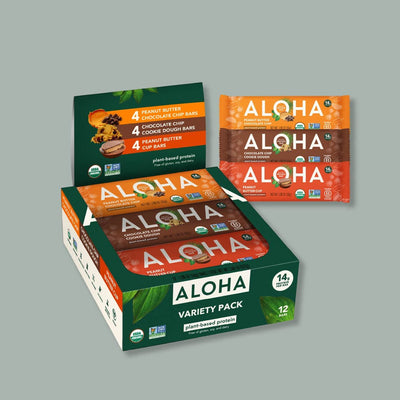Key Takeaways:
- Taro Is a Traditional Staple: Used for centuries in global cuisines, taro root carries cultural significance and culinary depth. It’s a meaningful ingredient with history behind every bite.
- Easy to Cook and Use: Taro fits into everyday meals with minimal effort. Whether boiled, mashed, or added to soups, it’s a no-fuss ingredient that works with familiar cooking methods.
- Supports a Whole-Food Diet: Taro nutrition fits naturally into a clean eating plan without additives or artificial ingredients. It offers real value in a simple, recognizable form.
Looking for a new way to bring variety to your plant-based meals without overcomplicating things? There’s a root vegetable that’s been quietly nourishing communities worldwide for generations—taro. With its creamy texture, slightly nutty flavor, and versatility in sweet and savory dishes, taro is more than just a tropical root—it’s a cultural staple worth discovering.
At ALOHA, we craft plant-based, organic, and non-GMO products, celebrating real ingredients and responsible sourcing. As a proud B Corp and Climate Neutral Certified company, we’re driven by a passion for better food and a better planet. Our bragging rights? We make delicious snacks with integrity, and our Taro Bar is just one example of how we bring that mission to life.
In this piece, we’ll explore taro nutrition, where this root comes from, how it fits into a whole-food lifestyle, and why it’s gaining attention from those who care about what’s on their plate—and where it comes from.
What Is Taro Root?
Taro root is a starchy tuber from the Colocasia esculenta plant, which is widely cultivated in tropical and subtropical regions around the world. Recognized by its brown, hairy skin and creamy white or purple-speckled flesh, taro has been a staple in traditional diets across Asia, Africa, the Pacific Islands, and the Caribbean for centuries.
Unlike more familiar root vegetables, taro has a unique texture that becomes smooth and slightly sweet when cooked. It’s commonly steamed, boiled, mashed, or made into chips and desserts. The root is not meant to be eaten raw due to natural compounds that need to be cooked down, but once prepared, it opens up a world of culinary possibilities.
As part of many cultural cuisines, taro often holds culinary and symbolic value. In places like Hawaii, it’s considered a sacred food tied to family and tradition. That depth of history and cultural respect makes taro more than just a trendy ingredient—it’s a globally respected plant with deep roots.
And when it comes to taro nutrition, this root offers a naturally occurring mix of carbohydrates, fiber, and key micronutrients, making it a smart addition to a well-rounded plant-based lifestyle.
Top Health Benefits Of Taro Root
Taro may not be as hyped as some trendy superfoods, but it’s quietly packed with value recognized for generations. It fits naturally into a balanced lifestyle, especially for those who enjoy plant-based, whole-food eating without relying on artificial additives. Let’s take a closer look at what makes taro nutrition worth paying attention to:
A Natural Source Of Energy
Taro root provides complex carbohydrates that digest gradually and offer lasting fuel. This makes it a great ingredient for meals that sustain you throughout the day without spikes and crashes. It supports a steady rhythm in your daily routine—something active lifestyles and everyday eaters appreciate.
Rich In Plant-Based Fiber
Fiber is an important part of a balanced diet; taro delivers it in a simple, unprocessed form. Including fiber-rich foods like taro can help support regularity and make meals more satisfying. It’s a small, natural way to round your plate with whole-food texture and substance.
Contains Essential Minerals
Taro root naturally contains potassium, magnesium, and manganese—minerals your body uses in various day-to-day functions. These aren’t flashy nutrients but do meaningful work behind the scenes. Adding taro is a subtle, no-fuss way to bring that nutritional diversity from a real, earth-grown source.
Includes Beneficial Vitamins
Taro also contains small amounts of vitamin C and B6, contributing to your overall nutrient variety. These vitamins appear in taro as part of a naturally occurring package, not from anything added. It’s another example of how taro supports a whole-food approach without extra processing or enrichment.
Naturally Gluten-Free And Versatile
For those seeking naturally gluten-free options, taro fits the bill without needing to be modified or re-engineered. Its mild taste and creamy texture work in various dishes, from savory meals to sweet treats. That kind of flexibility makes it an easy win for kitchens of all kinds.
Taro In A Plant-Based Diet
Taro fits comfortably into a plant-based lifestyle without needing any major adjustments. It’s a whole, real food that doesn’t rely on artificial flavors, added sugars, or lab-made ingredients to make an impact. Whether you’re fully plant-based or simply looking to diversify your meals, taro offers easy compatibility with clean, mindful eating:
- Complements Other Plant-Based Staples: Taro pairs well with beans, lentils, leafy greens, and spices, making it easy to include in everything from curries to grain bowls. Its neutral taste lets other ingredients shine while adding substance and balance. It’s a reliable base that works with the flavors and textures plant-based eaters love.
- Adapts to a Variety of Cuisines: Because taro has a long history in global dishes, it already has a place in many plant-focused meals. From Hawaiian poi to Filipino desserts and Polynesian stews, it brings authenticity and comfort. This makes it perfect for anyone exploring global cuisine with a plant-based lens.
- Provides Whole-Food Satisfaction: Taro has a naturally dense and creamy texture that brings comfort without needing anything extra. It gives that “stick-to-your-ribs” feeling by using only what nature puts in the root. That makes it ideal for anyone looking to eat more intuitively, choosing nourishing and familiar ingredients.
Is Taro Good For Everyone? Here’s What To Know
Taro is generally well-tolerated by many people, especially when prepared properly. But like any whole food, it’s not a one-size-fits-all ingredient. Here are a few things to keep in mind before adding taro to your regular meals:
Taro Should Always Be Cooked First
Raw taro contains naturally occurring compounds that can irritate the throat and stomach. Cooking neutralizes these elements, making the root safe and enjoyable to eat. Whether it’s boiled, baked, or steamed, always make sure it’s thoroughly cooked before serving.
Some People May Need To Introduce It Slowly
If taro is new to your diet, starting with small portions is a good idea. Like any starchy vegetable, it can take time for your system to adjust if unfamiliar. This approach helps you understand how your body responds without overwhelming your digestive routine.
Be Mindful Of Individual Dietary Needs
Everyone’s body is different, and what works for one person might not work for another. While taro offers value to various eating patterns, those with specific dietary restrictions should check in with a trusted professional if they have concerns. It’s all about finding what fits best for your individual needs.
Easy Ways To Add Taro To Your Meals
Taro is surprisingly versatile once you know how to work with it. From savory dishes to comforting snacks, it blends into everyday meals without fancy prep. If you’re curious about how to include more taro nutrition in your routine, here are some simple ideas to get started:
- Some Turn It Into a Taro Bar: Taro’s creamy texture and natural flavor make it a great base for snack bars. When blended with nuts, seeds, and other whole ingredients, it can be shaped into a compact, plant-based bar that’s easy to enjoy on the go. It’s one more creative way people incorporate taro nutrition into modern, mindful eating habits.
- Try It as a Side Dish: Boiled or steamed taro is a great alternative to potatoes or rice. Add a pinch of salt, herbs, or a drizzle of olive oil for a simple, satisfying side dish. It’s a subtle way to introduce this root into your meal rotation without changing much else.
- Incorporate It Into Soups and Stews: Taro holds its shape well when cooked, making it perfect for hearty soups and stews. It absorbs flavors from broths and spices while adding its creamy texture. This is a comforting option, especially for cooler months or cozy dinners at home.
- Make It Into a Mash or Puree: Similar to mashed potatoes, taro can be boiled and blended into a soft, smooth mash. A touch of garlic, coconut milk, or a sprinkle of fresh herbs takes it to the next level. This works well as a base for plant-based bowls or alongside roasted veggies.
- Use It in Sweet Treats: Taro is used in desserts in many cultures thanks to its mild, slightly sweet flavor. You can find it in puddings, steamed cakes, and even ice cream. This unexpected side of taro shows how flexible it can be in the kitchen.
Final Thoughts
Choosing ingredients like taro is a reminder that nourishment can be simple, rooted in tradition, and deeply satisfying. It’s not about chasing trends—it’s about honoring the kind of food that fuels us naturally and aligns with a mindful, balanced lifestyle. When you bring taro into your kitchen, you’re not just adding variety to your meals—you’re embracing a grounded, whole-food approach that supports your well-being from the inside out.
Read also:
- Protein For Vegetarians: Steps To Meet Daily Protein Needs
- Benefits Of Superfoods: Why They Boost Your Health
- Superfood Recipes: Easy And Healthy Meal Ideas
Frequently Asked Questions About Taro Nutrition
Is taro root high in calories?
Taro root is moderate in calories, similar to other starchy vegetables like potatoes. It provides a steady source of energy without being calorie-dense. It’s easy to fit into a balanced, plant-based diet when prepared simply.
Can taro be used in baking?
Yes, taro can be baked into cakes, breads, and pastries, especially in cuisines where it’s used as a naturally sweet and dense base. It can also be ground into flour for alternative baking. Its unique flavor brings a mild, nutty twist to classic baked goods.
What does taro root taste like?
Taro has a mild, slightly nutty flavor with earthy undertones. When cooked, it has a creamy texture similar to a cross between a potato and a chestnut. The subtle flavor makes it great for both sweet and savory dishes.
Is taro root the same as ube?
No, taro and ube are different plants, though they’re often confused due to their appearance and use in desserts. Ube is a purple yam with a sweeter, more vibrant flavor. Taro has a paler interior and a more neutral taste.
Can you freeze cooked taro?
Yes, taro can be frozen after it’s cooked and cooled completely. It reheats well in stews or soups without losing its texture. To maintain its quality, store it in an airtight container.
Is taro used in traditional medicine?
In some cultures, taro has been a folk remedy for centuries. While it carries traditional significance, it’s always best to view taro as a food, not a treatment. It’s valued more for its role in nourishing meals than in medical use.
What’s the difference between taro root and taro leaves?
Taro root is the edible tuber, while the leaves are consumed in certain cooked dishes. Both parts must be cooked thoroughly due to naturally occurring compounds. They each offer unique textures and uses in cooking.
How long does taro root last after buying?
Fresh taro root can last up to a week when stored in a cool, dry place. If refrigerated, it should be kept dry to avoid mold. Always check for softness or an off-smell before cooking.
Is taro nutrition suitable for kids?
Yes, taro can be kid-friendly when cooked properly and served in small, manageable portions. Its mild flavor is generally well-received by younger palates. Just cook it thoroughly to ensure it's easy to digest.
Does taro have a glycemic index?
Taro does have a glycemic index, but due to its fiber content, it tends to be lower than some other starchy vegetables. However, individual responses can vary. It is best to consume it as a balanced meal with other whole foods.
Sources:
1. Saxby, S., Lee, C., & Li, Y. (2021). Nutritional, Physicochemical, and Functional Properties of Five Varieties of Taro (Colocasia esculenta). Current Developments in Nutrition, 5(Supplement_2), 607–607. https://doi.org/10.1093/cdn/nzab044_038
2. Ferdaus, M. J., Chukwu-Munsen, E., Foguel, A., & da Silva, R. C. (2023). Taro Roots: An Underexploited Root Crop. Nutrients, 15(15), 3337. https://doi.org/10.3390/nu15153337
3. Mitharwal, S., Kumar, A., Chauhan, K., & Taneja, N. K. (2022). Nutritional, phytochemical composition and potential health benefits of taro (Colocasia esculenta L.) leaves: A review. Food Chemistry, 383, 132406. https://doi.org/10.1016/j.foodchem.2022.132406
ALOHA's products are not intended to treat, diagnose, mitigate, prevent, or cure disease. ALOHA's products should not replace prescribed medications or the variety of foods important to a healthful diet.
Do not self-diagnose any health condition. Work with your healthcare provider to determine how best to achieve optimal health.












